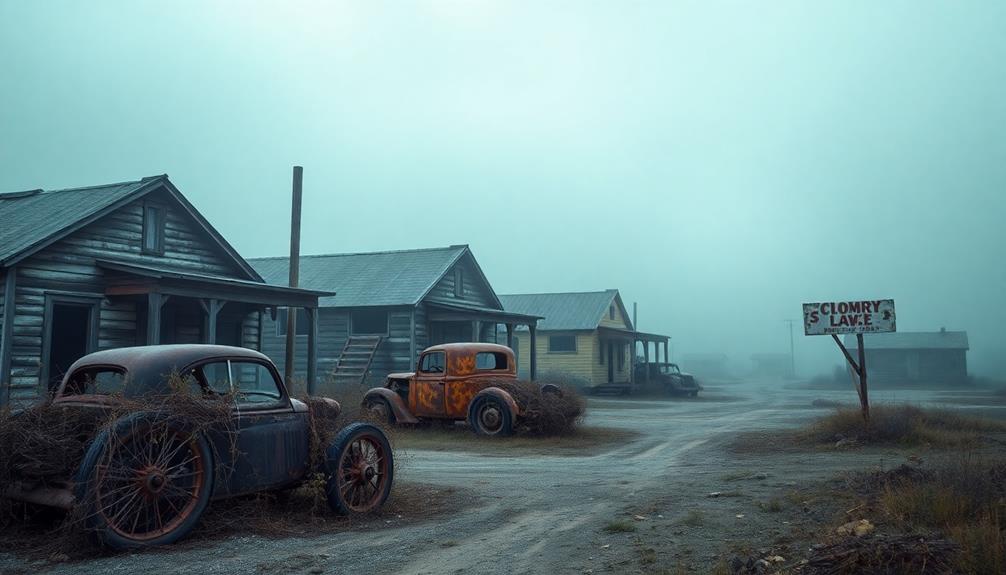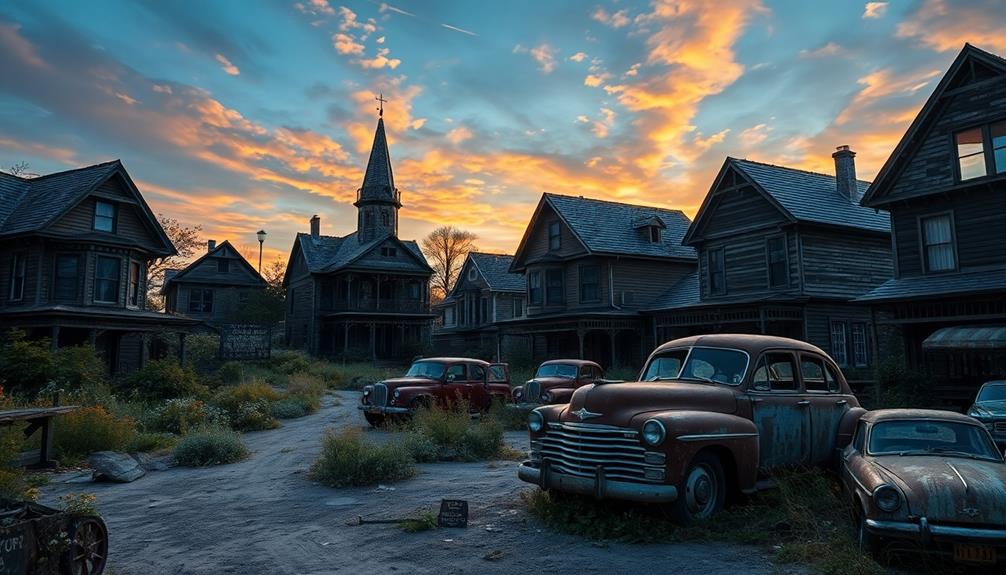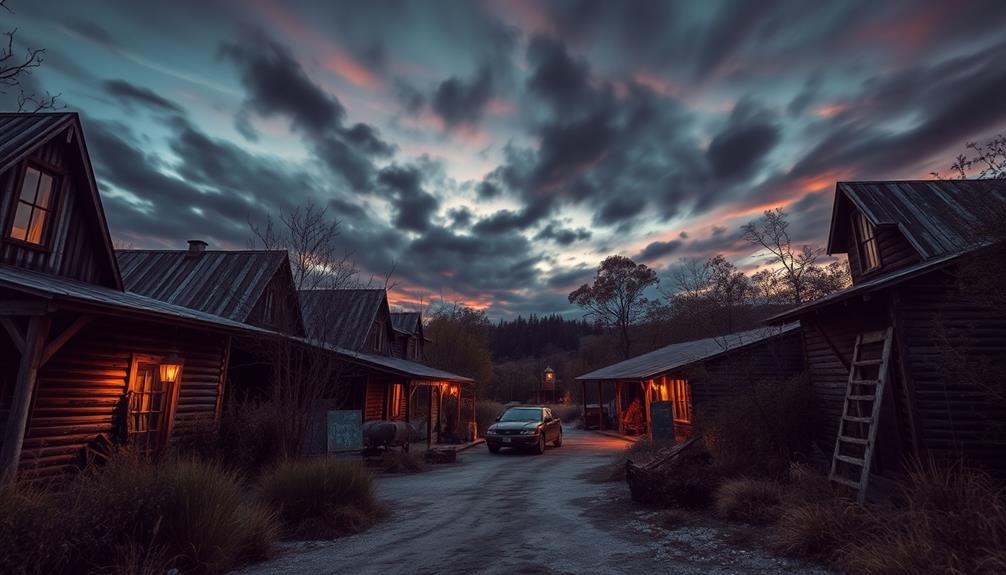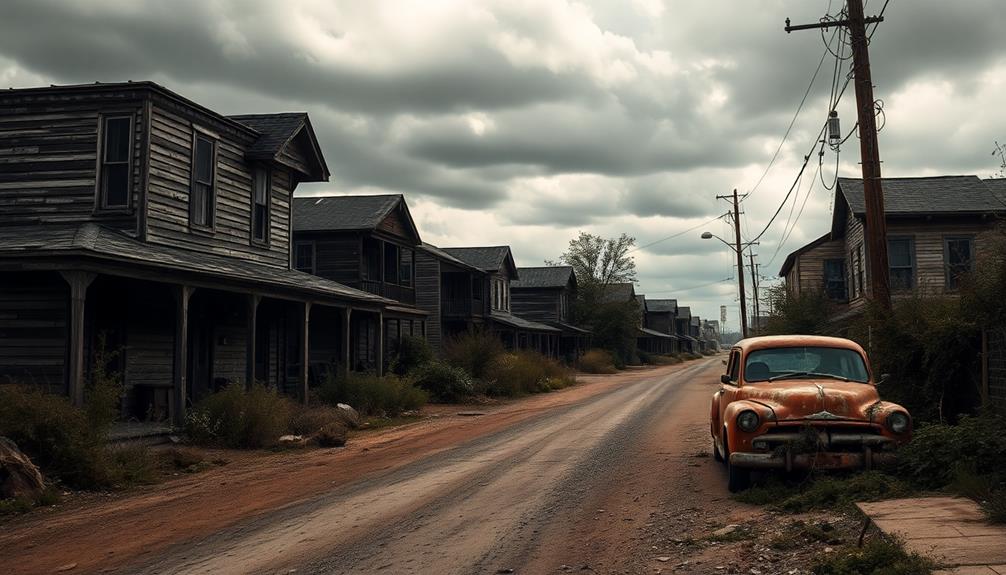Abandoned towns across the U.S. reveal chilling snapshots of history. These ghost towns, like Bodie in California or Centralia in Pennsylvania, serve as haunting reminders of prosperous pasts turned desolate. When you explore these eerie sites, you're not just witnessing decay; you're connecting with the stories of those who once lived there. Each town holds unique features that can send shivers down your spine, like the smoke still rising in Centralia from an underground mine fire. Keep going, and you'll uncover even more chilling tales and hidden gems waiting to be explored in these frozen moments of time.
Key Takeaways
- Ghost towns like Bodie, California, represent historical narratives of economic prosperity during the Gold Rush and subsequent decline.
- Centralia, Pennsylvania, is haunted by an underground coal fire, creating an eerie atmosphere with smoke rising from cracked streets.
- Virginia City, Montana, is rich in Gold Rush history, attracting ghost hunters with its tales of adventure and crime.
- Preservation efforts in ghost towns face challenges such as funding limitations and increased visitor traffic, risking the integrity of these historical sites.
- Exploring these towns offers unique photography opportunities, guided tours, and a deep connection to past lifestyles and community stories.
Overview of Abandoned Towns
Abandoned towns, often called ghost towns, are fascinating remnants of history that reveal stories of prosperity turned to desolation.
These eerie places once thrived due to economic booms, particularly during the Gold Rush era, but have since succumbed to economic decline, natural disasters, or social upheaval. You might find that many ghost towns are scattered across the western United States, with notable examples like Bodie, California, a well-preserved mining town that offers a glimpse into the past.
As a tourist or urban explorer, you'll be drawn to the unique ambiance of these deserted locales. The crumbling structures frozen in time evoke a sense of mystery and nostalgia.
Preservation efforts vary greatly; some ghost towns are maintained as historical parks, while others suffer from neglect, vandalism, and harsh weather.
Visiting these abandoned towns is more than just a trip; it's an opportunity to connect with history. You'll experience firsthand the stories of those who once lived there and witness the remnants of a time when these settlements were bustling with life.
Historical Context of Ghost Towns

The allure of ghost towns lies in their historical significance, showcasing the rise and fall of communities shaped by economic booms and busts. Many of these ghost towns originated during the Gold Rush era, when towns rapidly sprang up to support resource extraction.
However, as resources dwindled, these once-thriving communities often fell into decline, leaving behind remnants of their vibrant past.
You'll find that many ghost towns, like Bodie, California, and Virginia City, Montana, are preserved as historical sites. They provide you with a glimpse into 19th-century life and the profound impacts of resource extraction on local economies.
Other towns, such as Centralia, Pennsylvania, faced abandonment due to environmental disasters, like the underground mine fire that has burned since 1962, forcing residents to leave for safety.
These historical ghost towns are reminders of societal changes and economic fluctuations. They illustrate how external factors—industrialization, transportation advancements, and natural disasters—can lead to community decline.
Archaeological studies in these areas reveal artifacts that help historians piece together the daily lives and cultural identities of the people who once called these towns home.
Notable Abandoned US Towns

Exploring notable abandoned towns across the United States reveals fascinating stories of prosperity turned to desolation.
One standout is Bodie, California, a preserved ghost town that once thrived during the gold rush with a peak population of 10,000. Here, you can walk through the remnants of the Wild West boomtown, feeling as if time has stood still.
Another haunting location is Centralia, Pennsylvania. This abandoned city was nearly depopulated after an underground coal fire ignited in 1962, leaving cracked roads and smoke rising eerily from the ground.
Virginia City, Montana, offers a different experience. This well-preserved Gold Rush town showcases its rich history of adventure and crime, attracting those keen to step back into its lively past.
Similarly, Garnet, Montana, another ghost town, provides insights into the mining community that once flourished there.
While not in the U.S., Craco, Italy is often mentioned for its dramatic cliffs and preservation after being abandoned in the 1990s.
Each of these towns tells a unique story of ambition, decline, and the relentless passage of time.
Eerie Attractions and Features

Eerie attractions and features draw visitors to abandoned towns, where time seems to stand still, and shadows of the past linger. Exploring ghost towns like Bodie, California, offers a glimpse into the Wild West, with over 100 buildings preserved in a haunting state of "arrested decay." In Centralia, Pennsylvania, you'll experience the chilling remnants of an underground coal mine fire, still smoldering since 1962, with smoke creeping from cracked streets.
Take a look at some memorable stops you might encounter:
| Town | Notable Features |
|---|---|
| Bodie | Preserved buildings from the gold rush |
| Centralia | Underground mine fire with visible smoke |
| Kolmanskop | Sand-buried structures from diamond mining |
| Pyramiden | Intact Soviet-era buildings |
| St. Elmo | Reported hauntings and ghost stories |
These abandoned places not only reveal history but also hold stories of hauntings, making them compelling sites for adventurers. So, pack your bags and prepare for an unforgettable journey into the eerie past!
Economic Impact of Ghost Town Tourism

While many may see abandoned towns as relics of the past, ghost town tourism has emerged as a vibrant economic force in the United States. Each year, approximately 100 million tourists visit these ghost towns, considerably boosting local economies through various tourism-related activities and services.
This economic impact is profound, as towns often rely on tourism for their sustainability and community development.
Preservation projects not only help maintain these historical sites, but they also create job opportunities for locals. Educational programs offered in ghost towns enhance visitor engagement, promoting local history and often leading to increased spending in surrounding areas. Revenue generation comes from entry fees, guided tours, and artisan markets, all of which uplift struggling communities.
Prominent examples like Bodie, California, and Virginia City, Montana, showcase how effective historical preservation can transform abandoned sites into profitable tourist destinations.
By tapping into the allure of ghost towns, communities can harness their rich history to attract visitors, creating a cycle of economic growth that benefits everyone involved.
Preservation Efforts and Challenges

Ghost towns, though often thriving with tourism, face significant preservation challenges that threaten their historical essence. You might be surprised to learn that maintaining their historical integrity is no easy task. Here are some of the main obstacles preservation efforts encounter:
- Limited Funding: Many ghost towns rely on state or national park designations for financial support, but funds are often insufficient for extensive maintenance. This situation mirrors the challenges faced by seniors in managing health conditions, such as the cognitive impacts of medications like gabapentin, which can also drain resources for care.
- Weathering and Vandalism: These sites are vulnerable to natural elements and human interference, leading to deterioration of fragile structures. Just like the humor and connection found in seniors texting humor, which helps alleviate feelings of isolation, community engagement can bolster preservation efforts.
- Visitor Traffic: Increased tourism can contribute to the degradation of these towns, making it imperative to balance visitor access with preservation needs.
- Community Involvement: Local groups play an essential role in leading preservation initiatives, but their efforts can be hampered without active community support.
To combat these challenges, community involvement is important. By engaging in preservation projects, towns can't only protect their heritage but also create job opportunities that bolster heritage tourism.
Supporting these endeavors guarantees that ghost towns remain a fascinating reflection of history for generations to come.
Exploration Opportunities in Ghost Towns

Exploring ghost towns offers you a unique mix of hiking trails through stunning landscapes and the chance to capture incredible photographs of historical ruins.
You can join guided tours that share fascinating stories about the towns' past, making your adventure both enlightening and enjoyable.
Each ghost town has its own charm, waiting for you to uncover its hidden treasures.
Hiking Trails and Adventures
Venturing into abandoned towns offers a unique opportunity to hike through history, where well-preserved trails guide you past the remnants of bygone eras.
Exploring these ghost towns combines outdoor adventure with cultural education, making for an unforgettable visitor experience. Here are some highlights of what you can expect:
- Bodie, California: Designated hiking trails lead you through this historic town, showcasing abandoned buildings and the stories they hold.
- Bannack, Montana: Discover significant historical landmarks as you hike through trails designed to enhance your understanding of this ghost town's past.
- Garnet: Enjoy routes that offer breathtaking scenic vistas, giving you a glimpse of the natural beauty surrounding the historic remnants.
- Virginia City: Experience the thrill of hiking while you uncover the rich history and fascinating structures left behind.
Photography and Aesthetic Appeal
The allure of abandoned towns extends beyond hiking trails; they present a treasure trove for photography enthusiasts seeking to capture the haunting beauty of decaying structures. Ghost towns in America, like Bodie, California, offer a glimpse into the Wild West era, with tables set for dinner and shops still stocked with goods.
The unique aesthetic of abandoned buildings creates striking photographic opportunities that showcase nature's reclamation of human-made environments. As you explore iconic sites such as Virginia City, Montana, with over 300 original buildings, you'll find diverse backdrops for storytelling through imagery.
The interplay of light and shadow in these decaying spaces allows for dramatic compositions that highlight the beauty of decay and abandonment. Places like Centralia, Pennsylvania, with visible smoke from underground coal fires, exude an eerie atmosphere that draws photographers enthusiastic to capture haunting landscapes.
Each corner of these ghost towns tells a story, revealing historical architecture and the poignant effects of time. Armed with your camera, you can immortalize the haunting charm of these forgotten places, creating art that resonates deeply with the themes of loss and nostalgia.
Guided Historical Tours
While you may wander through the haunting remnants of abandoned towns, guided historical tours offer a structured way to uncover the rich stories and history behind these ghostly places.
Here are four must-visit ghost towns that provide engrossing experiences:
- Bodie, California: Explore this well-preserved Gold Rush town, where buildings stand untouched, revealing the lifestyle of miners and their families.
- Virginia City, Montana: Join a guided tour to explore the town's lawless past, featuring over 300 original structures and tales of notorious figures.
- Bannack State Park, Montana: Discover the first territorial capital, where guided tours showcase preserved buildings and artifacts from the 1860s gold rush.
- Centralia, Pennsylvania: Although limited, tours here educate you about the underground mine fire that has burned since 1962, shedding light on its environmental and social impacts.
These guided tours not only highlight the remnants of past lives but also immerse you in the engrossing histories of mining and community that shaped these ghost towns.
Whether it's the gold rush or a haunting fire, each story awaits your exploration.
Environmental Considerations

When you explore abandoned towns, you'll notice the ecological impacts of their neglect, from crumbling buildings that threaten local ecosystems to the rise of unique wildlife habitats.
These areas can become reclaimed by nature, offering opportunities for increased biodiversity as wildlife returns to thrive in the absence of human activity.
However, it's essential to contemplate preservation efforts that balance restoration with environmental protection.
Ecological Impacts of Abandonment
Often, abandoned towns serve as unexpected laboratories for ecological change. Without human interference, wildlife may reclaim these areas, leading to the development of unique ecosystems.
However, the ecological impacts of abandonment can be both positive and negative. Here are some key considerations:
- Local Biodiversity: Native species often flourish, while invasive species can also thrive in disturbed environments.
- Environmental Hazards: Deteriorating structures may release hazardous materials like lead and asbestos, contaminating soil and water.
- Habitat Loss: Flooding, as seen in places like Villa Epecuén, can alter ecosystems considerably, risking salinization and habitat loss for existing species.
- Preservation Efforts: Sustainable practices in ghost town restoration aim to minimize ecological disruption, ensuring that surrounding habitats remain protected.
While some abandoned sites foster new ecological balance, they also present challenges that must be managed.
Understanding these ecological impacts is vital as we navigate the delicate relationship between human history and nature's resilience.
Wildlife Reclamation Opportunities
Abandoned towns can become crucial refuges for wildlife, offering unique opportunities for species to thrive in areas once dominated by human activities. As these spaces are reclaimed, diverse ecosystems often emerge, allowing native plants and animals to flourish without human interference.
For instance, in Centralia, Pennsylvania, wildlife has adapted remarkably to the new conditions created by an underground mine fire, showcasing nature's resilience.
These abandoned areas not only boost biodiversity but also serve as significant sites for preservation efforts. When restoration projects prioritize environmental considerations, they enhance habitats while maintaining historical integrity. This balance guarantees that we can honor the past while fostering a thriving natural environment.
Moreover, wildlife reclamation can be an essential part of environmental education. As you explore these ghost towns, you'll learn about the ecological benefits of allowing nature to reclaim abandoned spaces.
Understanding these dynamics fosters a deeper appreciation for the interconnectedness of ecosystems and the role each species plays. By recognizing the potential of these abandoned towns, we can support initiatives that promote both wildlife preservation and the historical significance of these unique locations.
The Haunting Stories Behind the Towns

In the shadows of their once-thriving past, many abandoned towns in the U.S. hold haunting stories that echo through time. Each ghost town status brings with it a chilling narrative, often tied to the residents left behind.
Here are four towns that capture the imagination:
- Bodie, California: Preserved as a state historic park, Bodie showcases tables set for dinner and shops stocked with goods, a snapshot of life frozen in time.
- Centralia, Pennsylvania: An underground mine fire has left this town smoldering since 1962, with only a dozen residents remaining in a landscape of cracked streets and visible smoke.
- Virginia City, Montana: Known for its Gold Rush tumult, this town attracts ghost hunters with over 300 original buildings said to be haunted by intriguing ghosts of the past.
- Cahawba, Alabama: Once the state capital, its archaeological park now features historical markers that tell the haunting stories of families affected by flooding and economic decline.
These abandoned towns reveal a rich tapestry of history and mystery, inviting you to explore their chilling legacies.
Future of Abandoned Communities

Many abandoned communities are poised for a future that blends preservation with innovation. Preservation efforts are vital for transforming ghost towns into historical sites that attract tourists and educate visitors about local history.
As interest in these cultural heritage sites grows, you might see increased funding opportunities for restoration projects, allowing communities to thrive again.
Digital archiving and virtual tours are revolutionizing how people engage with these abandoned places. You can explore the history of ghost towns from the comfort of your home, gaining insights into economic shifts and societal changes that have shaped these areas.
Collaborations among historians, local governments, and communities will be essential in ensuring these sites remain relevant and informative for future generations.
Educational resources derived from these towns could serve as valuable tools for schools and local initiatives. By prioritizing preservation and innovative approaches, you'll witness a renewed appreciation for ghost towns and their stories.
This blend of the past and future can create a sustainable path forward, ensuring that the legacy of these communities continues to educate and inspire.
Frequently Asked Questions
Are There Any Real Ghost Towns Left in the United States?
Yes, there are real ghost towns left in the United States. You can explore well-preserved sites like Bodie in California or Virginia City in Montana, where remnants of past lives and stories await your discovery.
What Is the Largest Abandoned Town in the United States?
Imagine a ghostly ship adrift in a sea of time. Centralia, Pennsylvania, is the largest abandoned town in the U.S., a haunting reminder of an underground fire that still burns beneath its cracked streets.
What State Has the Most Abandoned Towns?
You'll find California boasts the most abandoned towns in the U.S., with over 300 ghost towns. These remnants from the Gold Rush era tell fascinating stories of prosperity and decline, capturing your imagination.
What Is the Most Famous Ghost Town?
When you think of the most famous ghost town, Bodie, California likely comes to mind. Once a thriving gold mining hub, it now captivates visitors with its preserved structures and haunting Wild West history.
Conclusion
Exploring abandoned towns might seem eerie or even unsettling, but these ghostly places offer a tangible connection to history and a glimpse into lives once lived. You'll find that each decaying building and overgrown street tells a story, inviting your curiosity rather than fear. While some worry about safety, many towns are accessible and well-preserved for exploration. So, embrace the atmosphere and uncover the mysteries that await; you just might discover a newfound appreciation for the past.










